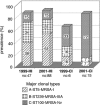Evolution and molecular characterization of methicillin-resistant Staphylococcus aureus epidemic and sporadic clones in Cordoba, Argentina
- PMID: 16390969
- PMCID: PMC1351928
- DOI: 10.1128/JCM.44.1.192-200.2006
Evolution and molecular characterization of methicillin-resistant Staphylococcus aureus epidemic and sporadic clones in Cordoba, Argentina
Abstract
Since 1999, a new, epidemic, methicillin-resistant Staphylococcus aureus (MRSA) strain, named the "Cordobes clone," has emerged in Argentina and coexists with the pandemic Brazilian clone. The purpose of this study was to determine the stability over time of the new clone and to investigate its evolutionary relationship with epidemic international MRSA lineages and with other MRSA and methicillin-susceptible S. aureus (MSSA) major clones distributed in this region. One hundred three MRSA isolates recovered in 2001 from Cordoba, Argentina, hospitals and 31 MSSA strains collected from 1999 to 2002 were analyzed by their antibiotic resistance patterns, phage typing, and pulsed-field gel electrophoresis. Additionally, representative members of most MRSA defined genotypes (A, B, C, E, K, and I) were characterized by multilocus sequence typing (MLST) and spaA and SCCmec typing. The most prevalent MSSA pulsotypes were also analyzed by MLST. Our results support the displacement of the Brazilian clone (sequence type [ST] 239, spaA type WGKAOMQ, SCCmec type IIIA) by the Cordobes clone (ST5, spaA type TIMEMDMGMGMK, SCCmec type I) in the hospital environment. MRSA and MSSA isolates shared only ST5. The data support the origin of the Cordobes clone as a member of a lineage that includes the pediatric and New York/Japan international clones and that is genetically related to the British EMRSA-3 strain. Interestingly, the pediatric clone, isolated from most community-acquired infections in Cordoba, was characterized by ST100, a single-locus variant of ST5 and a new variant of SCCmec type related to SCCmec type IVc.
Figures




Similar articles
-
High frequency of Panton-Valentine leukocidin genes in invasive methicillin-susceptible Staphylococcus aureus strains and the relationship with methicillin-resistant Staphylococcus aureus in Córdoba, Argentina.Eur J Clin Microbiol Infect Dis. 2007 Apr;26(4):281-6. doi: 10.1007/s10096-007-0278-4. Eur J Clin Microbiol Infect Dis. 2007. PMID: 17345057
-
[Infectivity-resistotype-genotype clustering of methicillin-resistant Staphylococcus aureus strains in the Central Blacksea Region of Turkey].Mikrobiyol Bul. 2014 Jan;48(1):14-27. Mikrobiyol Bul. 2014. PMID: 24506712 Turkish.
-
Evolutionary relationships between sporadic and epidemic strains of healthcare-associated methicillin-resistant Staphylococcus aureus.Clin Microbiol Infect. 2008 Jul;14(7):659-69. doi: 10.1111/j.1469-0691.2008.02015.x. Clin Microbiol Infect. 2008. PMID: 18558938
-
The evolution of Staphylococcus aureus.Infect Genet Evol. 2008 Dec;8(6):747-63. doi: 10.1016/j.meegid.2008.07.007. Epub 2008 Jul 29. Infect Genet Evol. 2008. PMID: 18718557 Review.
-
Bridges from hospitals to the laboratory: genetic portraits of methicillin-resistant Staphylococcus aureus clones.FEMS Immunol Med Microbiol. 2004 Mar 8;40(2):101-11. doi: 10.1016/S0928-8244(03)00370-5. FEMS Immunol Med Microbiol. 2004. PMID: 15040388 Review.
Cited by
-
Genetic and phenotypic diversity of methicillin-resistant Staphylococcus aureus among Japanese inpatients in the early 1980s.Sci Rep. 2021 Mar 8;11(1):5447. doi: 10.1038/s41598-021-84481-6. Sci Rep. 2021. PMID: 33686133 Free PMC article.
-
Mosaic staphylococcal cassette chromosome mec containing two recombinase loci and a new mec complex, B2.Antimicrob Agents Chemother. 2007 Jan;51(1):390-3. doi: 10.1128/AAC.00921-06. Epub 2006 Nov 6. Antimicrob Agents Chemother. 2007. PMID: 17088487 Free PMC article.
-
Clinical and microbiological aspects of linezolid resistance mediated by the cfr gene encoding a 23S rRNA methyltransferase.J Clin Microbiol. 2008 Mar;46(3):892-6. doi: 10.1128/JCM.01886-07. Epub 2008 Jan 3. J Clin Microbiol. 2008. PMID: 18174304 Free PMC article.
-
Methicillin-resistant Staphylococcus aureus in hospitals in Tbilisi, the Republic of Georgia, are variants of the Brazilian clone.Eur J Clin Microbiol Infect Dis. 2008 Aug;27(8):757-60. doi: 10.1007/s10096-008-0500-z. Epub 2008 May 15. Eur J Clin Microbiol Infect Dis. 2008. PMID: 18481123
-
Efficacy, safety, tolerability and population pharmacokinetics of tedizolid, a novel antibiotic, in Latino patients with acute bacterial skin and skin structure infections.Braz J Infect Dis. 2016 Mar-Apr;20(2):184-92. doi: 10.1016/j.bjid.2015.12.007. Epub 2016 Feb 7. Braz J Infect Dis. 2016. PMID: 26859064 Free PMC article. Clinical Trial.
References
-
- Amorim, M. L., M. Aires de Sousa, I. S. Sanches, R. Sa-Leao, J. M. Cabeda, J. M. Amorim, and H. de Lencastre. 2002. Clonal and antibiotic resistance profiles of methicillin-resistant Staphylococcus aureus (MRSA) from a Portuguese hospital over time. Microb. Drug Resist. 8:301-309. - PubMed
-
- Bantar, C., A. Famiglietti, M. Goldberg, et al. 2000. Three-year surveillance study of nosocomial bacterial resistance in Argentina. Int. J. Infect. Dis. 4:85-90. - PubMed
-
- Bantar, C., A. Famiglietti, M. Radice, et al. Comparative analysis during two periods of prevalence from 1999 to 2003. Bulletins 144, 153, 158, and 167. (In Spanish.) Asociación Argentina de Microbiología, Buenos Aires, Argentina. [Online.] http://www.aam.org.ar/archivos/167_SIR.pdf.
Publication types
MeSH terms
Substances
LinkOut - more resources
Full Text Sources
Molecular Biology Databases

